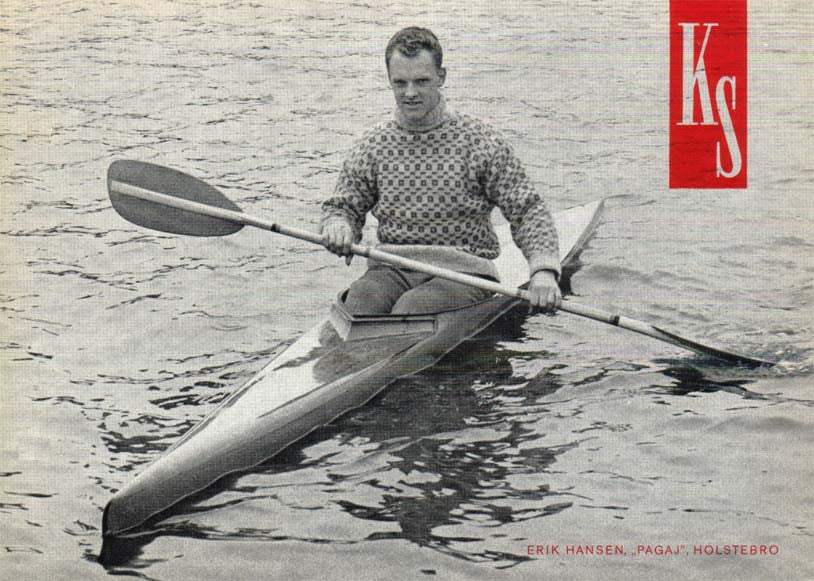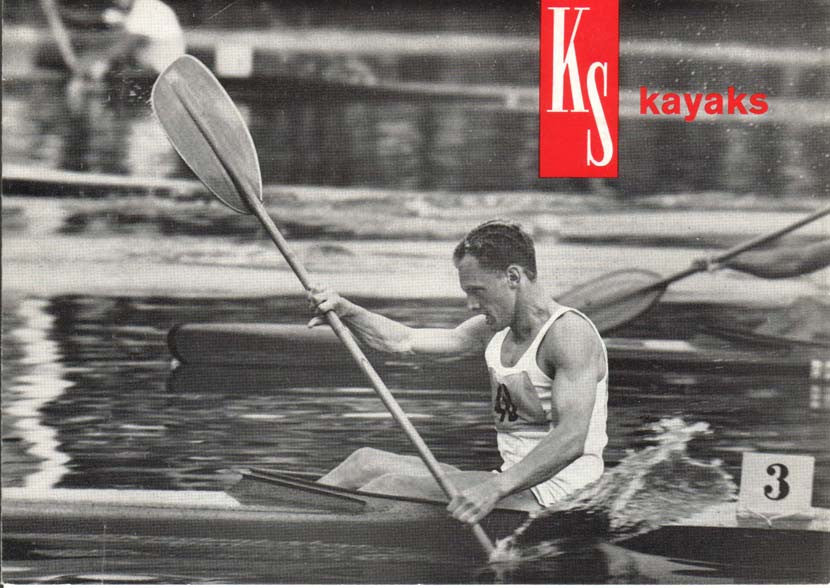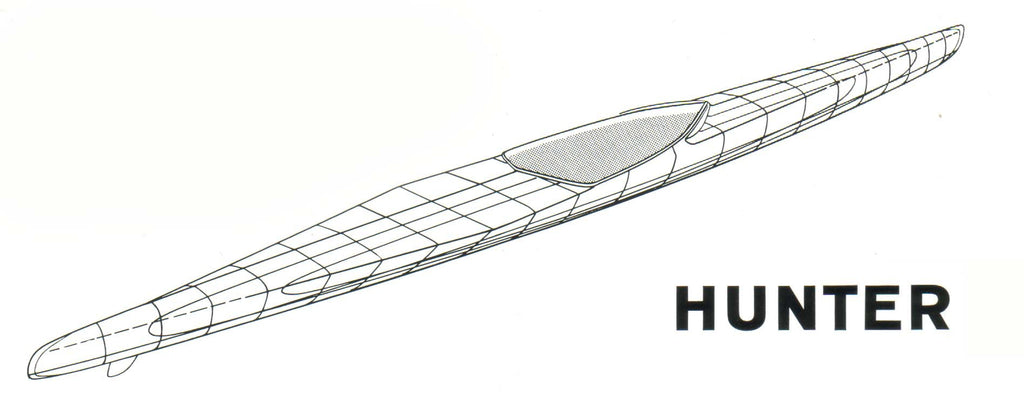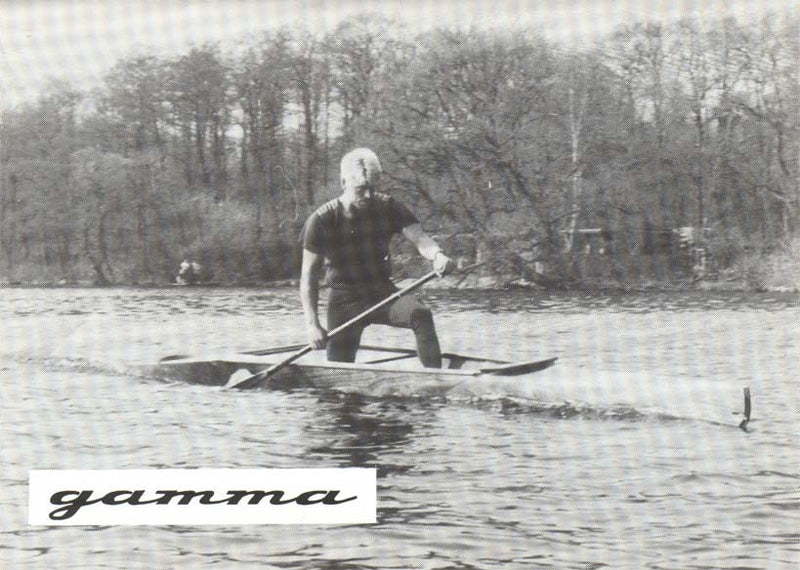In kayak racing tow models have got a very strong reputation, namely the K1 ”HUNTER” and the K2 ”GLIDER”. In the European championships 1967 they were very near to be the only models used by the competitors. These kayaks are also impressive on account of there appearance and in the following we shall explain the background for there special shape.
Both kayaks have a very narrow fore body with “the measured beam” – excuse the expression – located far abaft the middle. Whether we find this shape pretty or ugly it is necessary. Could you perhaps do without the maximum of freedom which is necessary in making the paddle-work really efficient?
Do you remember the “FIGHTER”. Fritz Briel who weighs 15 stones (95 kilos) won several races in this boat. Slim girls of 8½ stones (55 kilos) also brought championships home in this boat. It raised somewhat, but not too much, in the strokes, was quite stable, reliable in sea and unsurpassed in speed. It was prohibited in 1963. Even after the concave prohibition it is easy enough to make the kayaks narrow in the bottom, but it is difficult with the same WL-beam to obtain the same displacement as before. This is partly due to the narrow fore body partly to the fact that parts of the V-shape from the hull above WL of the aft body comes under water. The result becomes a larger wetted area and consequently an increased frictional resistance.
With the “HUNTER” Jørgen Samson has drawn a convex kayak whose wetted surface is 11/3 sq. inch (12 cm2) smaller than that of the concave “FIGHTER” and the smallest until now. The lines of the two boats are identical. You cannot see any difference, and the boats move equally through the water. “HUNTER” is, however, somewhat narrower, as this boat is only supposed to cover loads up till 187 lbs. (85 kilos).
The well-known lines are calculated with new methods to make the form 100 % even, and 30 years of experience with kayaks tell us that with the “HUNTER” we have build the best and fastest single kayak.
It was necessary to make “HUNTER” about an inch higher at its widest point than normally to prevent that any part of the projecting freeboards comes under the water-line. The gunwale which already in the “POINTER” had a reverse sheer line must in the “HUNTER” be even more angular – in the same way as a C1.
Jørgen Samson has never concealed that he did not like this little maritime shape which – as expected – followed the changes in the rules of measurement in 1963. Therefore he introduced in “HUNTER” and “GLIDER” a new deck-shape which counterbalances the reverse sheer line, and at the same time he took the opportunity to revise the traditional V-shaped deck.
The deck has always given the kayaks their typical silhouette: high at the cockpit and low at the ends. Is this form appropriate? The modern kayaks are widest aft and consequently the V-shaped deck becomes highest in the aft body which beforehand is high on account of the “width of measurement”. Here we find the reason why we have to use the rudder vigorously in a side wind: The high aft body turns the boat against the wind.
“HUNTER” is much lower than other kayaks and the wind drift is reduced by at least 10 %. In the middle the deck is flat, but it gradually passes into a more rounded shape which becomes higher and steeper towards the ends. This results in a very beautiful and harmonic contour, which is so well calculated that the boat can keep its course in a side wind, without any use of the rudder, and accordingly without loss in speed.
In sea or just in the wake from a competitor’s kayak the usual deck has always been inclined to slow down speed. As the deck becomes lower and lower towards the stem its plane flats will point slantingly down and therefore cut the fore body deeper down in the waves. The sharp gunwale edges do not make things better and if the bow is low at the same time the risk of losing speed is often great.
“HUNTER`s” deck does not lose height towards the stem and it is shaped so that it merges into the bottom without any gunwale edge. Thereby the fore body increase its buoyancy and the smooth shape works softly in the sea without any tendency of cutting down.
After the long narrow fore body had been accepted all over it was discovered that it has not only advantages but also disadvantages. It is easy to understand that the buoyancy was not too good and in order not to make the boats too narrow under the water-line they got vertical sides in the fore body. Further abaft the sides were made much tilted to obtain “the measured beam”. Such a tremendous change of the shape of the sections is not very fortunate for the water resistance and furthermore it makes the boat extremely sensitive towards changes in the load.
Now one should think that the narrow fore body at any rate had to be favourable to the wave resistance, but many canoeists had a feeling that the boat was not lively enough, they almost got stuck in the water. In short they did the opposite of planing.
A fore body with flat vertical freeboards forms a bow-wave which is inclined to slide high along the sides of the boat. This results in an increased frictional resistance and is felt like certain unwillingness on top-speed. Curved freeboards are better fit to divert the bow wave so that it does not stick along the sides. The shape which is applied in the “HUNTER” gives back the fore body the missing buoyancy and thereby contributes to a correct distribution of the total displacement.
If you look at “HUNTER`s” bottom you will feel no doubts that it is narrow, the WL-beam is about one inch (2 cm) smaller than that of the “FIGHTER” and the “POINTER”. The “HUNTER” does not draw deeper in the water and this is due to an incredible concentration in buoyancy within the given measures.
As in the “FIGHTER” the sectional form changes only little in the whole bottom of the “HUNTER”. The buoyancy increases rapidly upwards all over in the hull, which gives two good qualities: A completely acceptable stability and universality as regards the loading. “HUNTER” gives the highest speed possible to all canoeists between 79 and 134 stones (50 and 85 kilos).
“HUNTER” has the width which is necessary in order that the canoeist can sit in it, neither less nor more. Freedom for movement cannot be any greater. The sides of the cockpit are equal to the sides of the hull so there is no bothering gunwale-edge. The cover is fastened behind the wave guard, hereby the closing becomes waterproof even with considerable waves, and the spray-cover is easily pulled off in the event of capsizing.
The rudder is placed neat the stern. It has been made deeper and consequently more efficient so that less than one sq. inch of wetted surface can be saved. The hatch-cover has been replaced by a nylon bush. At request the boat can also be delivered with the rudder wheel free above the deck.
The seat adjustment is now made on a fine-toothed nylon band. The system is very solid and far more precise than the previous one.











